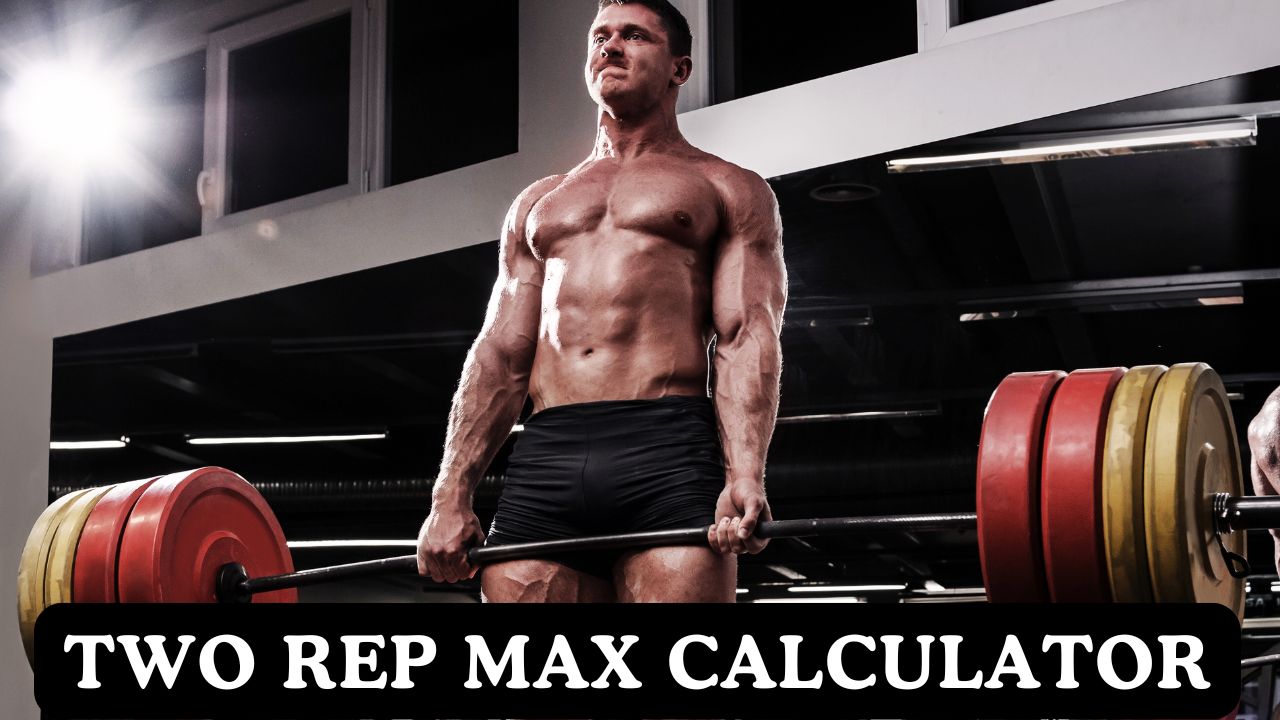2 Rep Max Calculator
Calculate your Two Rep Max (2RM) using scientifically validated formulas. Get personalized training recommendations and percentage-based workout plans optimized for maximum strength, power, and neural adaptation.

Two Rep Max (2RM) Training
The Two Rep Max (2RM) represents the maximum weight an individual can lift for exactly two repetitions with perfect form. Research in Sports Medicine demonstrates that 2RM testing provides the optimal balance between maximum strength assessment and practical safety. The 2RM typically represents approximately 95% of an individual’s 1RM, making it the most reliable predictor of maximum strength without the extreme risks of 1RM testing.
Neural Adaptation Benefits
Neuromuscular research shows that 2RM training optimizes neural drive and motor unit recruitment patterns more effectively than higher rep ranges. Training at 90-100% of 2RM maximizes neural adaptations including increased firing frequency, improved synchronization, and enhanced intermuscular coordination. This makes 2RM training essential for powerlifters and strength athletes.
Competitive Applications
Athletic performance studies indicate that 2RM strength correlates most strongly with competition performance in strength sports. The ability to perform two consecutive maximum effort repetitions closely mimics the demands of powerlifting competition where lifters must demonstrate consistent strength across multiple attempts. Elite powerlifters regularly use 2RM testing in their preparation cycles.
Safety Advantages
Injury prevention research demonstrates that 2RM testing significantly reduces injury risk compared to 1RM attempts while maintaining excellent reliability for strength assessment. The ability to complete two repetitions allows for better form consistency, reduces psychological stress, and provides a safety margin that pure 1RM testing cannot offer.
2RM Calculation Methods & Scientific Validation
Brzycki Formula for 2RM
Formula: 2RM = (1RM × 36 ÷ (37 – Reps)) × 0.95
Validation research
shows the Brzycki formula provides exceptional accuracy for 2RM predictions when combined with the 95% conversion factor.
This method is particularly effective for compound movements and has been validated across multiple strength levels and age groups.
Epley Formula for 2RM
Formula: 2RM = (Weight × (1 + 0.0333 × Reps)) × 0.95
The Epley formula, when adjusted for 2RM calculation, provides outstanding accuracy across diverse exercise types and populations.
This formula is particularly valuable for programming purposes as it tends to be slightly conservative, providing built-in safety
margins for training prescription. It works excellently for both upper and lower body exercises.
Direct 2RM Testing Protocol
Protocol: Systematic loading to determine actual 2RM
Direct 2RM testing involves progressive load increases until the lifter can complete exactly two repetitions with maximum effort.
This method provides the most accurate assessment and is preferred by competitive powerlifters and strength athletes. Requires
experienced supervision, proper warm-up protocols, and adequate recovery between attempts.
Multi-Formula Precision
Approach: Combined formula averaging for maximum accuracy
Using multiple validated formulas and averaging results provides superior precision compared to single-formula calculations.
This method eliminates individual formula bias and provides the most reliable 2RM estimates across different populations,
training backgrounds, and exercise variations. Essential for precise program design and progression tracking.
2RM vs Other Rep Max Comparisons
| Rep Max | % of 1RM | Neural Demand | Safety Level | Competition Relevance | Testing Frequency |
|---|---|---|---|---|---|
| 1RM | 100% | Maximum | Highest Risk | Direct | Rare |
| 2RM | 95% | Very High | Good | Excellent | Monthly |
| 3RM | 90% | High | Very Good | Good | Bi-weekly |
| 5RM | 85% | Moderate-High | Excellent | Moderate | Weekly |
When to Use 2RM Testing
Optimal Applications:
• Competition preparation for powerlifting and strength sports
• Advanced athletes seeking maximum neural adaptation
• Strength assessment for elite training programs
• Peaking phases before major competitions
• Experienced lifters with excellent technique mastery
• When maximum strength data is critical for program design
Elite 2RM Strength Standards
Male 2RM Strength Standards (kg)
| Exercise | Beginner | Novice | Intermediate | Advanced | Elite |
|---|---|---|---|---|---|
| Bench Press | 40-55kg | 55-75kg | 75-95kg | 95-125kg | 125kg+ |
| Squat | 50-75kg | 75-100kg | 100-130kg | 130-165kg | 165kg+ |
| Deadlift | 60-90kg | 90-120kg | 120-155kg | 155-195kg | 195kg+ |
| Overhead Press | 25-40kg | 40-55kg | 55-70kg | 70-85kg | 85kg+ |
Female 2RM Strength Standards (kg)
| Exercise | Beginner | Novice | Intermediate | Advanced | Elite |
|---|---|---|---|---|---|
| Bench Press | 20-32kg | 32-47kg | 47-62kg | 62-78kg | 78kg+ |
| Squat | 30-50kg | 50-70kg | 70-90kg | 90-115kg | 115kg+ |
| Deadlift | 40-60kg | 60-80kg | 80-105kg | 105-135kg | 135kg+ |
| Overhead Press | 15-25kg | 25-35kg | 35-45kg | 45-58kg | 58kg+ |
2RM Standards Interpretation
These 2RM standards represent approximately 95% of established 1RM benchmarks, adjusted for elite strength populations. Standards assume excellent technique, extensive training experience, and optimal conditions. Individual variations exist based on body composition, limb lengths, training specialization, and genetic factors. Use these as aspirational targets for long-term strength development rather than immediate requirements.
Advanced 2RM Periodization Model
| Training Phase | Duration | Intensity (%2RM) | Volume (Reps) | Sets | Rest Period | Primary Adaptation |
|---|---|---|---|---|---|---|
| Strength Foundation | 4-6 weeks | 65-80% | 6-10 | 3-4 | 3-4 min | Hypertrophy, technique |
| Strength Building | 4-6 weeks | 80-90% | 3-6 | 4-5 | 4-5 min | Strength development |
| Neural Adaptation | 3-4 weeks | 90-95% | 2-4 | 4-6 | 5-6 min | Maximum neural drive |
| Competition Peak | 2-3 weeks | 95-100% | 1-2 | 3-5 | 5-7 min | Competition preparation |
| Recovery/Deload | 1 week | 50-70% | 5-8 | 2-3 | 2-3 min | Active recovery |
2RM Periodization Benefits
Advanced periodization research demonstrates that 2RM-based programming produces superior strength gains in experienced lifters compared to traditional percentage-based programs. The ability to regularly assess and adjust 2RM values allows for precise autoregulation and optimal neural adaptation while maintaining excellent safety profiles.
Elite 2RM Training Techniques
2RM Cluster Training
Protocol: 2 × (1+1) with 15-20 seconds between singles
Intensity: 95-100% 2RM
Benefits: Maintains maximum power output, allows multiple near-max attempts
This advanced method enables frequent practice at 2RM loads while managing fatigue effectively. Essential for competition preparation.
2RM Wave Loading
Protocol: 85% × 2, 90% × 2, 95% × 2, repeat with 2-5% increases
Application: Progressive waves building to 2RM
Benefits: Post-activation potentiation, neural priming
Particularly effective for competition simulation and maximum strength development in advanced athletes.
Competition Simulation
Method: 2RM attempts with competition timing and commands
Intensity: 90-100% 2RM
Benefits: Competition preparation, psychological adaptation
Critical for powerlifters and strength athletes who must perform under competition conditions and official commands.
Frequently Asked Questions
How often should I test my 2RM?
Beginners: Every 8-12 weeks during strength phases
Intermediate: Every 4-6 weeks during strength blocks
Advanced: Every 2-4 weeks during peaking phases
Elite/Competition: Weekly during competition preparation
2RM testing can be performed more frequently than 1RM testing due to improved safety margins and reduced fatigue.
What’s the optimal 2RM testing protocol?
Warm-up Protocol:
1. General warm-up: 5-10 minutes dynamic movement
2. Specific warm-up and activation exercises
3. 50% 2RM × 5-8 reps
4. 70% 2RM × 3-5 reps
5. 85% 2RM × 2-3 reps
6. 90% 2RM × 2 reps
7. 2RM attempt
Rest 4-5 minutes between heavy sets, 5-6 minutes before 2RM attempt.
How does 2RM relate to competition performance?
Competition Relationships:
• 1RM = 2RM ÷ 0.95 (approximately 105% of 2RM)
• Competition opener = 2RM × 0.85-0.90
• Competition second = 2RM × 0.95-1.00
• Competition third = 2RM × 1.02-1.05
These relationships help powerlifters select optimal competition attempts based on 2RM performance.
Is 2RM testing suitable for all lifters?
2RM testing is most appropriate for intermediate to advanced lifters with excellent technique and substantial training experience. Beginners should focus on higher rep ranges (5-8RM) until they develop proper movement patterns and strength base. Athletes with injury history should consult with qualified professionals before attempting 2RM testing.
What indicates a successful 2RM attempt?
Success Criteria:
• Both repetitions completed with excellent form
• Consistent bar path and tempo throughout
• No significant form breakdown on second rep
• Full range of motion maintained
• No assistance required from spotters
• Third repetition would be impossible or compromise form
If additional reps are clearly possible, the weight does not represent a true 2RM.
2RM Training Safety & Recovery
Pre-2RM Testing Preparation
48-72 Hours Before:
• Optimal sleep schedule (8-9 hours nightly)
• Proper hydration and nutrition periodization
• Avoid high-intensity training sessions
• Mental preparation and visualization
• Equipment inspection and setup
• Spotter briefing and safety protocols
Comprehensive preparation is essential for both performance and safety in 2RM testing.
Post-2RM Recovery Protocol
Immediate (0-4 hours): Light stretching, hydration, quality protein intake
24-48 Hours: Active recovery, massage, anti-inflammatory nutrition
48-96 Hours: Light training only, monitor for excessive fatigue
Return to Training: Gradual intensity progression over 4-7 days
Proper recovery ensures optimal adaptation and prepares the nervous system for subsequent training.
Critical 2RM Safety Considerations
Essential Safety Measures:
• Experienced spotters familiar with the lifter’s technique
• Proper safety equipment (racks, bars, collars)
• Emergency procedures and communication protocols
• Conservative attempt selection and progression
• Abort criteria for form breakdown or pain
• Medical clearance for lifters with injury history
Never compromise safety for performance in 2RM testing.
Related
- Barbell Racking Calculator
- Push-Up Weight Calculator
- Wilks Calculator
- DOTS Calculator
- One-Rep (1RM) Max Calculator
- One-Rep Max (1RM) Bench Press Calculator
References
- Knutzen, Kathleen; Brilla, Lorraine; Caine, Dennis (August 1999). “Validity of 1RM Prediction Equations for Older Adults”. The Journal of Strength & Conditioning Research. 13 (3): Vol 13, Issue 3, Page 242–246. Retrieved 11 July 2014.
- Epley, Boyd (1985). “Poundage Chart”. Boyd Epley Workout. Lincoln, NE: Body Enterprises. p. 86.
- Brzycki, Matt (1998). A Practical Approach To Strength Training. McGraw-Hill.
- Kemmler, Wolfgang K.; Lauber, Dirk; Wassermann, Alfred; Mayhew, Jerry L. (2006-11-01). “Predicting maximal strength in trained postmenopausal woman”. Journal of Strength and Conditioning Research. 20 (4): 838–842.
- Reynolds, JM; Gordon, TJ; Robergs, RA (August 2006). “Prediction of one repetition maximum strength from multiple repetition maximum testing and anthropometry” (PDF). Journal of Strength and Conditioning Research. 20 (3): 584–92.
- Naclerio Ayllón, Fernando; Jiménez Gutiérrez, Alfonso; Alvar, Brent A.; Peterson, Mark D. (2009). “Assessing strength and power in resistance training”. Journal of Human Sport and Exercise. 4 (2): 100–113.

Manish is a NASM-certified fitness and nutrition coach with over 10 years of experience in weight lifting and fat loss fitness coaching. He specializes in gym-based training and has a lot of knowledge about exercise, lifting technique, biomechanics, and more.
Through “Fit Life Regime,” he generously shares the insights he’s gained over a decade in the field. His goal is to equip others with the knowledge to start their own fitness journey.
